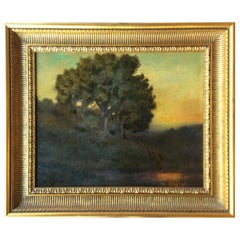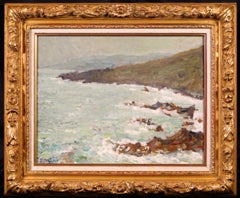Frank T Hutchens
Early 1900s Impressionist Figurative Paintings
Oil
People Also Browsed
Antique Late 19th Century American Barbizon School Paintings
Wood
Early 1900s Impressionist Landscape Paintings
Oil, Panel
2010s Contemporary Landscape Paintings
Canvas, Cotton Canvas, Oil
Mid-20th Century American Impressionist Figurative Paintings
Linen, Oil
Late 19th Century French School Animal Paintings
Canvas, Oil
2010s Contemporary Landscape Paintings
Oil, Canvas
Mid-20th Century Post-Impressionist Landscape Paintings
Canvas, Oil
Mid-20th Century Impressionist Landscape Paintings
Canvas, Oil
1930s American Realist Figurative Paintings
Oil, Board
Mid-20th Century Cubist Landscape Paintings
Watercolor
Antique Late 19th Century French Napoleon III Paintings
Canvas
Antique Late 19th Century French Paintings
Paper
17th Century French School Figurative Paintings
Canvas, Oil
Antique Early 1900s French Romantic Paintings
Wood, Paint
Mid-20th Century American Paintings
Paint
19th Century Portrait Drawings and Watercolors
Chalk
A Close Look at impressionist Art
Emerging in 19th-century France, Impressionist art embraced loose brushwork and plein-air painting to respond to the movement of daily life. Although the pioneers of the Impressionist movement — Claude Monet, Edgar Degas, Paul Cézanne, Berthe Morisot, Camille Pissarro, and Pierre-Auguste Renoir — are now household names, their work was a radical break with an art scene led and shaped by academic traditions for around two centuries. These academies had oversight of a curriculum that emphasized formal drawing, painting and sculpting techniques and historical themes.
The French Impressionists were influenced by a group of artists known as the Barbizon School, who painted what they witnessed in nature. The rejection of pieces by these artists and the later Impressionists from the salons culminated in a watershed 1874 exhibition in Paris that was staged outside of the juried systems. After a work of Monet’s was derided by a critic as an unfinished “impression,” the term was taken as a celebration of their shared interest in capturing fleeting moments as subject matter, whether the shifting weather on rural landscapes or the frenzy of an urban crowd. Rather than the exacting realism of the academic tradition, Impressionist paintings, sculptures, prints and drawings represented how an artist saw a world in motion.
Many Impressionist painters were inspired by the perspectives in imported Japanese prints alongside these shifts in European painting — Édouard Manet drew on ukiyo-e woodblock prints and depicted Japanese design in his Portrait of Émile Zola, for example. American artists such as Mary Cassatt and William Merritt Chase, who studied abroad, were impacted by the work of the French artists, and by the late 19th century American Impressionism had its own distinct aesthetics with painters responding to the rapid modernization of cities through quickly created works that were vivid with color and light.
Find a collection of authentic Impressionist art on 1stDibs.
Finding the Right figurative-paintings for You
Figurative art, as opposed to abstract art, retains features from the observable world in its representational depictions of subject matter. Most commonly, figurative paintings reference and explore the human body, but they can also include landscapes, architecture, plants and animals — all portrayed with realism.
While the oldest figurative art dates back tens of thousands of years to cave wall paintings, figurative works made from observation became especially prominent in the early Renaissance. Artists like Michelangelo, Leonardo da Vinci and other Renaissance masters created naturalistic representations of their subjects.
Pablo Picasso is lauded for laying the foundation for modern figurative art in the 1920s. Although abstracted, this work held a strong connection to representing people and other subjects. Other famous figurative artists include Francis Bacon and Lucian Freud. Figurative art in the 20th century would span such diverse genres as Expressionism, Pop art and Surrealism.
Today, a number of figural artists — such as Sedrick Huckaby, Daisy Patton and Eileen Cooper — are making art that uses the human body as its subject.
Because figurative art represents subjects from the real world, natural colors are common in these paintings. A piece of figurative art can be an exciting starting point for setting a tone and creating a color palette in a room.
Browse an extensive collection of figurative paintings on 1stDibs.
- Who is Frank Mariani?1 Answer1stDibs ExpertApril 5, 2024In the world of art, design and fashion, there are two answers to the question "Who is Frank Mariani?" because two people share that name in these fields. One is furniture designer Frank Mariani, who designed pieces for the Pace Collection, a manufacturer of high-end furniture. There is also the Beverly Hills-based tailor Frank Mariani, who designed suits for Ronald Reagan and a host of celebrities, including Bob Hope, Jimmy Stewart and Henry Fonda. Shop a collection of Frank Mariani furniture on 1stDibs.
- What is Frank Auerbach style?1 Answer1stDibs ExpertApril 5, 2022Frank Auerbach is a figure painter whose work has been described as expressionist, however, he more accurately fits into the neo-expressionist classification. He’s also been known for creating semi-abstract portraits, which puts him more accurately in the modern art movement. On 1stDibs, find a variety of original artwork from top artists.
- 1stDibs ExpertApril 5, 2022Frank Lloyd Wright broke away from Victorian-era architecture and created “Prairie-Style” out of the belief that there should be fewer, larger rooms that flowed easily. He was also a key player in the Art Deco movement. Shop a collection of expertly vetted Frank Lloyd Wright pieces from some of the world’s top sellers on 1stDibs.
- 1stDibs ExpertFebruary 27, 2024The name of Frank Gehry's chair depends on which piece you're referring to, as the designer has produced quite a few chairs over the course of his career. Arguably, his most famous chair is the S-shaped Wiggle chair, crafted out of corrugated cardboard. He also designed several chairs out of ribbon-like pieces of bent wood, such as the armless, low-backed Hat Trick chair, the curvy Cross Check chair and the tall High Sticking chair. On 1stDibs, find a collection of vintage Frank Gehry chairs.
- 1stDibs ExpertMarch 15, 2024A painter is the type of artist that Frank Bowling is. He is generally considered to be an Abstract Expressionist, and he tends to incorporate themes and symbols inspired by his Guyanese heritage. Some of his best-known works include Who's Afraid of Barney Newman, Spreadout Ron Kitaj, Middle Passage, Sacha Jason Guyana Dreams, Pondlife, Late Blue and Blue Trane. On 1stDibs, shop a range of Frank Bowling art.
- 1stDibs ExpertFebruary 1, 2024The style of Frank Lloyd Wright’s work is Prairie style. The architect pioneered the style, which draws inspiration from the natural beauty of the landscapes of the Midwest region of the U.S. Wright's design philosophy emphasized organic architecture, with buildings existing in harmony with their natural surroundings. His approach to architectural design had a profound influence on the shape of modern life, both while he was actively designing buildings and during the decades that followed. Shop a diverse assortment of Frank Lloyd Wright furniture on 1stDibs.
- 1stDibs ExpertMarch 22, 2022Yes, Frank Lloyd Wright designed furniture. He believed that the interior of a home should complement its exterior. As a result, he created unique pieces for many of the buildings he designed. Some of his most notable pieces include the Taliesin Group cabinet and the Allen table. Find a range of Frank Lloyd Wright furniture on 1stDibs.
- 1stDibs ExpertApril 5, 2022Yes, Frank Lloyd Wright made lamps. A stained-glass lamp he designed in the early 1900s was found at an antique shop in Chicago, abandoned during World War II. The lamp went on to break records at Christie’s auction, selling for over $700,000 in 1998. Shop a collection of expertly vetted Frank Lloyd Wright pieces from some of the world’s top sellers on 1stDibs.
- 1stDibs ExpertMay 7, 2024Frank Stella (1936–2024) made paintings, prints and sculptures. One of the central figures in postwar American art, Stella was a proponent of minimalism and non-representational abstraction. His famous works include Sinjerli Variation IV, Harran II and his “Eccentric Polygon” series.
Stella burst onto the scene barely out of college with his “Black Paintings,” sober geometric studies composed of wide black stripes separated by chalky white lines. These won him inclusion in “16 Americans,” the famed 1959–60 group show at New York’s Museum of Modern Art. He stayed at the forefront of art, working with famed gallerist Leo Castelli, relentlessly pursuing geometric form and never repeating himself.
Find a collection of Frank Stella art for sale on 1stDibs. - 1stDibs ExpertFebruary 27, 2024Frank Lloyd Wright used a variety of materials. For his homes and commercial buildings, the American architect favored natural materials and obtained them from local sources whenever possible. Some materials commonly featured in Wright's buildings include concrete, zinc, glass bricks, stone and wood. Wright’s wooden chairs and tables for his “Prairie Houses” of the early 1900s have sleek, attenuated forms, influenced by both the simplicity of traditional Japanese design and the work of Gustav Stickley and other designers of the Arts and Crafts movement. His desks and chairs for Johnson Wax have a streamlined look and feature tubular steel. Shop a variety of Frank Lloyd Wright furniture on 1stDibs.
- 1stDibs ExpertFebruary 27, 2024Frank Lloyd Wright's most famous house is arguably in Mill Run, a small community located in the Laurel Highlands region of southwestern Pennsylvania. Wright designed the home, called Fallingwater, in 1935 for the Kaufman family, who founded and owned a department store chain. Located around 70 miles southeast of Pittsburgh, the home is now open for daily tours. Just 7 miles away from Fallingwater is a second Frank Lloyd Wright home, Kentuck Knob. Designed in 1954, it was formerly the home of the Hagan family, who were friends with the Kaufmans. Explore a range of Frank Lloyd Wright furniture on 1stDibs.
- 1stDibs ExpertFebruary 27, 2024The material used in Frank Gehry's Wiggle chair is the type of corrugated cardboard that is typically reserved for making architectural models. The piece comes from Gehry's Easy Edges collection of paper furniture. Gehry was inspired to produce the Wiggle chair and the rest of his Easy Edges pieces because he believed that the seating options available to consumers when the chair debuted in 1972 were too expensive. Find a selection of vintage Frank Gehry furniture on 1stDibs.
- 1stDibs ExpertFebruary 27, 2024Frank Lloyd Wright designed more than 1,000 homes and other structures over the course of his life. However, only about 400 of those designs were ever built. Some of his most famous homes include Fallingwater, the Frederick C. Robie House, the Hollyhock House, the Darwin D. Martin House and Taliesin. Explore a diverse assortment of Frank Lloyd Wright furniture on 1stDibs.
- 1stDibs ExpertApril 5, 2024There are four Frank Lloyd Wright houses in Pennsylvania. They include Fallingwater in Stewart Township, Kentuck Knob in Ohiopyle, Suntop Homes in Ardmore and the Don Duncan House in Acme. In addition, Wright designed the Francis Little House Library in Allentown and the Beth Sholom Synagogue in Elkins Park. On 1stDibs, explore a variety of Frank Lloyd Wright furniture.
- 1stDibs ExpertFebruary 27, 2024The style of furniture that Frank Lloyd Wright used varied. Wright's wooden chairs and tables for his “Prairie Houses” of the early 1900s have sleek, attenuated forms, influenced by both the simplicity of traditional Japanese design and the work of Gustav Stickley and other designers of the Arts and Crafts movement. For several residential projects, Wright designed severely geometric chairs that are marvels of reductivist design. For the Price Tower in Oklahoma, Wright designed angular wooden desks as well as upholstered pedestal chairs made of chromed steel that are more in line with the mid-century modern style. On 1stDibs, shop a range of Frank Lloyd Wright furniture.
- 1stDibs ExpertApril 5, 2022Frank Lloyd Wright's architecture style was known as the Prairie Style; his principles led to a better life for all. From low-pitched roofs to overhanging eaves against closed-in Victorian era designs, prevalent in their confined spaces, among other things. Find vintage and modern Frank Lloyd Wright's pieces from top sellers on 1stDibs.


